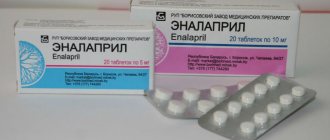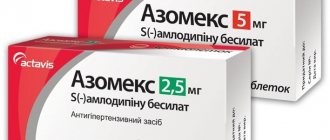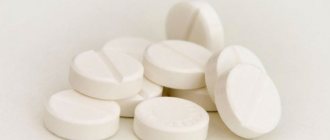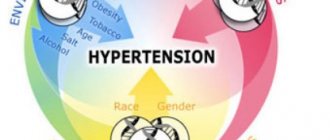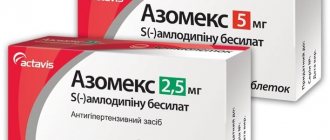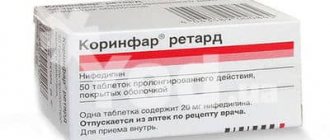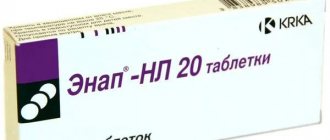Norvasc tablets 5 mg 30 pcs ➤ instructions for use
It can be expected that inhibitors of microsomal oxidation will increase the concentration of amlodipine in plasma, increasing the risk of side effects, and inducers of microsomal liver enzymes will decrease it.
With simultaneous use of Norvasc with cimetidine, the pharmacokinetics of amlodipine does not change.
Unlike other calcium channel blockers, no significant interaction was found with Norvasc® when used in combination with NSAIDs, especially indomethacin.
It is possible to enhance the antianginal and hypotensive effects of calcium channel blockers when used together with thiazide and loop diuretics, verapamil, ACE inhibitors, beta-blockers and nitrates; as well as an increase in their hypotensive effect when used together with alpha1-blockers and antipsychotics.
Although no negative inotropic effect was generally observed in studies of Norvasc®, some calcium channel blockers may enhance the negative inotropic effect of antiarrhythmic drugs that cause QT prolongation (for example, amiodarone and quinidine).
When used together with lithium drugs, calcium channel blockers (no data available for Norvasc) may increase the manifestation of their neurotoxicity (nausea, vomiting, diarrhea, ataxia, tremor, tinnitus).
Amlodipine does not affect the degree of plasma protein binding of digoxin, phenytoin, warfarin and indomethacin in vitro.
A single dose of aluminum/magnesium-containing antacids does not have a significant effect on the pharmacokinetics of amlodipine.
A single dose of sildenafil in a dose of 100 mg in patients with essential hypertension does not affect the pharmacokinetic parameters of amlodipine.
Repeated use of amlodipine at a dose of 10 mg and atorvastatin at a dose of 80 mg is not accompanied by significant changes in the pharmacokinetics of atorvastatin.
When amlodipine was administered concomitantly with digoxin in healthy volunteers, serum levels and renal clearance of digoxin did not change.
With single and repeated use at a dose of 10 mg, amlodipine does not have a significant effect on the pharmacokinetics of ethanol.
Amlodipine does not affect changes in prothrombin time caused by warfarin.
Amlodipine does not cause significant changes in the pharmacokinetics of cyclosporine.
A simultaneous single dose of 240 ml of grapefruit juice and 10 mg of amlodipine orally is not accompanied by a significant change in the pharmacokinetics of amlodipine.
Norvasc®
Amlodipine can be safely used for the treatment of arterial hypertension together with thiazide diuretics, alpha-blockers, beta-blockers or ACE inhibitors.
In patients with stable angina, amlodipine can be combined with other antianginal agents, for example, long- or short-acting nitrates, beta-blockers.
Unlike other BMCCs, no clinically significant interaction of amlodipine (III generation BMCCs) was found when used together with non-steroidal anti-inflammatory drugs (NSAIDs), including indomethacin.
It is possible to enhance the antianginal and hypotensive effect of BMCC when used together with thiazide and loop diuretics, ACE inhibitors, beta-blockers and nitrates, as well as to enhance their hypotensive effect when used together with alpha1-blockers, antipsychotics.
Although negative inotropic effects have generally not been observed in amlodipine studies, some CBMCs may enhance the negative inotropic effects of antiarrhythmic drugs that cause QT prolongation (eg, amiodarone and quinidine).
Amlodipine can also be safely used concomitantly with antibiotics and oral hypoglycemic agents.
A single dose of 100 mg of sildenafil in patients with essential hypertension does not affect the pharmacokinetic parameters of amlodipine.
Repeated use of amlodipine at a dose of 10 mg and atorvastatin at a dose of 80 mg is not accompanied by significant changes in the pharmacokinetics of atorvastatin.
Simvastatin
: Simultaneous repeated use of amlodipine at a dose of 10 mg and simvastatin at a dose of 80 mg leads to an increase in simvastatin exposure by 77%. In such cases, the dose of simvastatin should be limited to 20 mg.
Ethanol
(drinks containing alcohol):
amlodipine with single and repeated use in a dose of 10 mg does not affect the pharmacokinetics of ethanol.
Antivirals (ritonavir):
increases plasma concentrations of BMCC, including amlodipine.
Neuroleptics and isoflurane:
enhancing the hypotensive effect of dihydropyridine derivatives.
Calcium preparations
may reduce the effect of BMCC.
When combined with BMCC and lithium preparations
(no data available for amlodipine), possibly increasing the manifestation of their neurotoxicity (nausea, vomiting, diarrhea, ataxia, tremor, tinnitus).
Studies of the simultaneous use of amlodipine and cyclosporine in healthy volunteers and all groups of patients, with the exception of patients after kidney transplantation, have not been conducted.
Various studies of the interaction of amlodipine with cyclosporine in patients after kidney transplantation show that the use of this combination may not lead to any effect, or increase the minimum concentration of cyclosporine to varying degrees, up to 40%. These data should be taken into account and cyclosporine concentrations should be monitored in this group of patients when cyclosporine and amlodipine are used concomitantly.
Does not affect serum digoxin
and its renal clearance.
Does not significantly affect the action of warfarin
(prothrombin time).
Cimetidine
does not affect the pharmacokinetics of amlodipine.
in vitro studies
amlodipine does not affect the plasma protein binding of
digoxin
,
phenytoin
,
warfarin
and
indomethacin
.
Grapefruit juice:
A simultaneous single dose of 240 mg of grapefruit juice and 10 mg of amlodipine orally is not accompanied by a significant change in the pharmacokinetics of amlodipine. However, it is not recommended to use grapefruit juice and amlodipine at the same time, since genetic polymorphism of the CYP3A4 isoenzyme may increase the bioavailability of amlodipine and, as a result, enhance the hypotensive effect.
Aluminum- or magnesium-containing
antacids
: their single dose does not have a significant effect on the pharmacokinetics of amlodipine.
CYP3A4 isoenzyme inhibitors
: with simultaneous use of diltiazem at a dose of 180 mg and amlodipine at a dose of 5 mg in patients from 69 to 87 years of age with arterial hypertension. There is an increase in systemic exposure of amlodipine by 57%. Concomitant use of amlodipine and erythromycin in healthy volunteers (18 to 43 years of age) does not lead to significant changes in amlodipine exposure (increase in area under the concentration-time curve (AUC) by 22%). Although the clinical significance of these effects is unclear, they may be more pronounced in older patients.
Potent inhibitors of the CYP3A4 isoenzyme (for example, ketoconazole, itraconazole) may increase the plasma concentration of amlodipine to a greater extent than diltiazem. Amlodipine and inhibitors of the CYP3A4 isoenzyme should be used with caution.
Clarithromycin:
CYP3A4 isoenzyme inhibitor. Patients taking clarithromycin and amlodipine at the same time have an increased risk of low blood pressure. Patients taking this combination are advised to be under close medical supervision.
Inducers of the CYP3A4 isoenzyme
: There is no data on the effect of inducers of the CYP3A4 isoenzyme on the pharmacokinetics of amlodipine. Blood pressure should be carefully monitored during concomitant use of amlodipine and inducers of the CYP3A4 isoenzyme.
Tacrolimus
: When used simultaneously with amlodipine, there is a risk of increasing the concentration of tacrolimus in the blood plasma. To avoid toxicity of tacrolimus when used concomitantly with amlodipine, the concentration of tacrolimus in the blood plasma of patients should be monitored and the dose of tacrolimus should be adjusted if necessary.
Mammalian target of rapamycin (mTOR) inhibitors
mTOR inhibitors such as sirolimus, temsirolimus and everolimus are substrates of the CYP3A isoenzyme. Amlodipine is a weak inhibitor of the CYP3A isoenzyme. When used concomitantly with mTOR inhibitors, amlodipine may increase their exposure.
Norvasc, 5 mg, tablets, 14 pcs.
Amlodipine can be safely used for the treatment of arterial hypertension together with thiazide diuretics, α-blockers, β-blockers or ACE inhibitors. In patients with stable angina, amlodipine can be combined with other antianginal agents, such as long-acting or short-acting nitrates, beta-blockers.
Unlike other CCBs, a clinically significant interaction with amlodipine (III generation CCB) was not detected when used together with NSAIDs, incl. and with indomethacin.
It is possible to enhance the antianginal and hypotensive effect of CCBs when used together with thiazide and loop diuretics, ACE inhibitors, β-blockers and nitrates, as well as to enhance their hypotensive effect when used together with α1-blockers, antipsychotics.
Although negative inotropic effects have not generally been observed in amlodipine studies, some CCBs may potentiate the negative inotropic effects of antiarrhythmic drugs known to prolong the QT interval (eg, amiodarone and quinidine).
Amlodipine can also be safely used concomitantly with antibiotics and oral hypoglycemic agents.
A single dose of 100 mg of sildenafil in patients with essential hypertension does not affect the pharmacokinetic parameters of amlodipine.
Repeated use of amlodipine at a dose of 10 mg and atorvastatin at a dose of 80 mg is not accompanied by significant changes in the pharmacokinetics of atorvastatin.
Simvastatin:
simultaneous repeated use of amlodipine at a dose of 10 mg and simvastatin at a dose of 80 mg leads to an increase in simvastatin exposure by 77%. In such cases, the dose of simvastatin should be limited to 20 mg.
Ethanol (beverages containing alcohol):
amlodipine with single and repeated use at a dose of 10 mg does not affect the pharmacokinetics of ethanol.
Antivirals (ritonavir):
increases plasma concentrations of BCC, incl. and amlodipine.
Neuroleptics and isoflurane:
enhancing the hypotensive effect of dihydropyridine derivatives.
Calcium preparations
may reduce the effect of CCBs.
When combined with CCBs and lithium preparations
(no data available for amlodipine), their neurotoxicity may increase (nausea, vomiting, diarrhea, ataxia, tremor, tinnitus).
Studies of the simultaneous use of amlodipine and cyclosporine in healthy volunteers and all groups of patients, with the exception of patients after kidney transplantation, have not been conducted. Various studies of the interaction of amlodipine with cyclosporine in patients after kidney transplantation show that the use of this combination may not lead to any effect or increase the Cmin of cyclosporine to varying degrees, up to 40%. These data should be taken into account and cyclosporine concentrations should be monitored in this group of patients when cyclosporine and amlodipine are co-administered.
Does not affect serum digoxin
and its renal clearance.
Does not significantly affect the action of warfarin
(PV).
Cimetidine:
does not affect the pharmacokinetics of amlodipine.
in vitro studies
of digoxin, phenytoin, warfarin and indomethacin
to plasma proteins Grapefruit juice:
A simultaneous single dose of 240 mg of grapefruit juice and 10 mg of amlodipine orally is not accompanied by a significant change in the pharmacokinetics of amlodipine. However, it is not recommended to use grapefruit juice and amlodipine at the same time, because with genetic polymorphism of the CYP3A4 isoenzyme, it is possible to increase the bioavailability of amlodipine and, as a result, increase the hypotensive effect.
Aluminum or magnesium containing antacids:
their single dose does not have a significant effect on the pharmacokinetics of amlodipine.
CYP3A4 isoenzyme inhibitors:
with simultaneous use of diltiazem at a dose of 180 mg and amlodipine at a dose of 5 mg in elderly patients (69 to 87 years old) with arterial hypertension, an increase in systemic exposure of amlodipine by 57% was observed. Concomitant use of amlodipine and erythromycin in healthy volunteers (18 to 43 years of age) does not lead to significant changes in amlodipine exposure (22% increase in AUC). Although the clinical significance of these effects is unclear, they may be more pronounced in older patients.
Potent inhibitors of the CYP3A4 isoenzyme (for example, ketoconazole, itraconazole) may increase the plasma concentration of amlodipine to a greater extent than diltiazem. Amlodipine and inhibitors of the CYP3A4 isoenzyme should be used with caution.
Clarithromycin:
CYP3A4 isoenzyme inhibitor. Patients taking clarithromycin and amlodipine at the same time have an increased risk of decreased blood pressure. Patients taking this combination are advised to be under close medical supervision.
Inducers of the CYP3A4 isoenzyme:
There is no data on the effect of inducers of the CYP3A4 isoenzyme on the pharmacokinetics of amlodipine. Blood pressure should be carefully monitored while using amlodipine and inducers of the CYP3A4 isoenzyme.
Tacrolimus:
When used simultaneously with amlodipine, there is a risk of increasing the concentration of tacrolimus in the blood plasma. To avoid toxicity of tacrolimus when used concomitantly with amlodipine, the concentration of tacrolimus in the blood plasma of patients should be monitored and the dose of tacrolimus should be adjusted if necessary.
